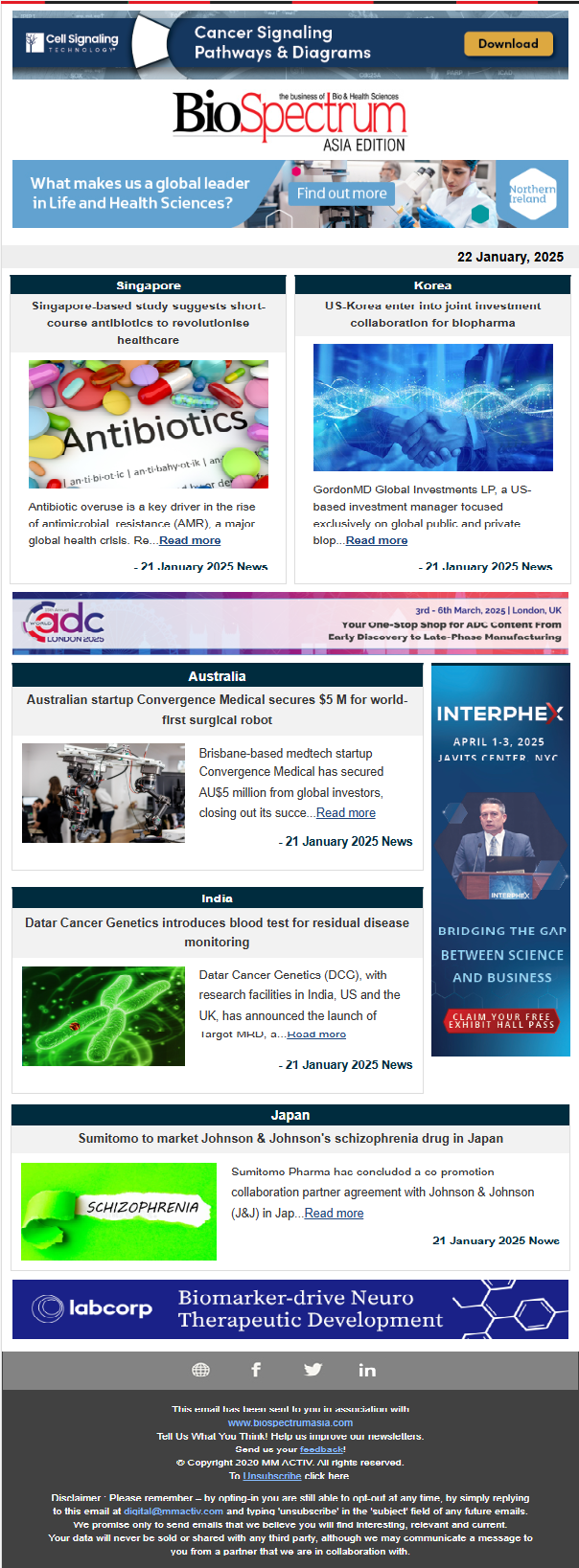
Singapore: Made up of thousands of volcanic islands and geographically located in few of the most disaster-prone areas of the world, Indonesia is the world's fourth most populous country and home to nearly 260 million people. Data from WHO Global Health Expenditure Database has revealed that, in 2014, Indonesia's spending on healthcare totalled only 2.8 percent of GDP. Compared to the global average of 9.9 percent, it goes without saying that the country's health expenditure is among the lowest in the world. On many healthcare parameters such as health status, infrastructure, access to medical services, quality, equity, Indonesia scores poorly among all Asian countries.
Currently, the Indonesian healthcare system is grappling with various issues such as under financing, low density of care providers, hospitals, limited access to drugs in rural areas, and overall inaccessibility and inequity of care provision. The utilisation levels of Indonesian healthcare infrastructure are very low because of widespread poverty, lack of availability, low confidence levels patients have in hospital and physician care, and corruption, amongst other factors. The country is however working towards building a healthy infrastructure and its healthcare expenditure is expected to grow at a rate of 12 percent CAGR for the next five years. This rise can be attributed to many factors like rising middle class, increased awareness about healthcare, urbanisation and most importantly the launch of Universal Healthcare Coverage- an ambitious programme by the Indonesian government that promises to set right the healthcare woes of the country.
Roll out of Universal Health Coverage
In a bid to revamp its healthcare system and provide affordable healthcare to all, the Indonesian government launched a Universal Healthcare Coverage (UHC) scheme-the Jaminan Kesehatan Nasional (JKN) in January 2014. JKN was implemented by the social security agency Badan Penyelenggara Jaminan Sosial Kesehatan (BPJS) and aims to provide all 255 million Indonesian citizens with access to a wide range of health services by 2019. JKN will also cover foreigners who work in Indonesia for at least six months. This ambitious programme has covered nearly 160 million people so far and once it covers all Indonesians, JKN will be the largest insurance programme in the world. Under JKN, all Indonesians will receive coverage for a range of treatments via health services from public providers as well as private organisations that have opted to join the scheme. Formally employed workers pay a premium worth 5 percent of their salary, with 1 percent being paid by the employee and 4 percent paid by employer. Informal workers and the self-employed pay a fixed monthly premium.
Speaking about the program, Ang Wei Zheng, Pharmaceutical and Healthcare Analyst, BMI Research, said, "The introduction of universal healthcare coverage in Indonesia has shaped the trajectory of the country's healthcare market in several ways. According to estimates, more than half of the population is now enrolled into the programme - known as the Jaminan Kesehatan Nasional (JKN) - which has facilitated access to medical services and treatment. Within the pharmaceutical industry, the policy has been a boon for generic drug sales in particular, as JKN mandates the use of this class of medicines where possible due to concerns over cost."
The launch of JKN is touted as a game changer and is expected to drive the rest of the country's health sector as a new model of supply and demand emerges. UHC has resulted in more people seeking healthcare because they have coverage, which in turn increases the need for hospital, infrastructure and medical supplies. JKN is expected to change the dynamics of healthcare in Indonesia, by raising the demand for drugs, medical equipment, hospitals and skilled labour. This rise in demand is expected to fuel the growth of Indonesia's healthcare sector inviting new foreign investors to cash-in on this burgeoning market.
Speaking to BioSpectrum on the implications of UHC changing the health scenario of Indonesia,Frost and Sullivan analysts Rhenu Bhuller, Partner, and Ryan Iswandi Kurniawan, Consultant - Indonesia, Transformational Health said, "UHC has improved access to healthcare market in Indonesia which resulted in market growth for the healthcare and pharmaceutical industry in the country. There is official data mentioning that the Ministry of Health has spent IDR 35.4 trillions in 2013 (prior BPJS) and in 2014 and 2015, the spending increased to IDR 47.6 and 48 trillions respectively. Additional impact has been in the improvement of access to healthcare reimbursement policies available under the UHC case-based group model and structured referral process where the primary care provider is positioned as a gatekeeper for secondary and tertiary health facilities. This also will lead to better streamlining and use of healthcare resources as well as pharmaceuticals and devices."
Indonesia's pharma market
Primarily driven by local players, the pharmaceutical market in Indonesia more than doubled from just under $3 billion in 2008 to reach approximately $7 billion in 2015 and is anticipated to increase further to $12.6 billion by 2020, according to research and consulting firm GlobalData. The local pharmaceutical market value has grown by 11 percent for the past five years and reached a value of 69 trillion IDR in 2015. Prescription medicines make up 59 percent of the market, while over-the-counter (OTC) drugs account for 41 percent. Undoubtedly, the JKN programme has made Indonesia one of the fastest growing pharmaceuticals markets in the region. Both domestic and foreign companies are expanding their production capacities to meet the expected demand growth over the next few years thanks to the programme. Increased penetration of JKN in rural areas and government support is expected to further drive this growth, boosting domestic production and increasing foreign investments. The most likely beneficiaries are local pharmaceutical companies producing generic drugs, which already have a 70 percent share of the local drug market by volume. The outlook for medtech and pharmacy is largely positive owing to the high potential of the market. The increased healthcare infrastructure spending has presented new opportunities for both medtech and pharmaceutical players.
"The market for generic pharmaceuticals and value-based products are areas of demand and growth as it will be more widely used to cope with the demand due to expanded access," highlighted Frost & Sullivan analysts. "Indonesia producers have looked into expanding production facilities in response to the demand. Industry players from China, India, Korea and European countries like Germany have shown interest or invested in the Indonesia market while more equity investment has been made in several listed companies such as Kalbe Farma and Pharos pharmaceutical. The medical diagnostics and devices market has expanded under the UHC with the expansion of primary care facilities and the step up referrals which are fuelling initial diagnosis and non-complex surgical procedures. The impact is lower in the complex surgeries as the barrier there is the availability of specialists as well as the infrastructure development of Class A/B hospitals," they said.
New economic policy packages, high prevalence of infectious diseases, widespread generic drug supply, increasing affordability of healthcare products and the large over-the-counter medicines market are few other drivers that are making Indonesia one of the most promising emerging markets. The government implemented two economic policy packages in 2015, as GDP growth slowed and inflation increased. These policies mainly focus on raising investment in Indonesia and offering more industrial facilities to attract investors.
As a consequence of high and consistent economic growth and burgeoning job opportunities, purchasing power has risen and demand for high-quality healthcare services has increased thanks to greater affordability and improved general health awareness. This will positively affect the growth of the Indonesian pharmaceutical market.
Wei Zheng said, "A major trend currently underway in Indonesia is the shift to have production of pharmaceutical raw materials localised in the country. The need to do so has been growing over the course of 2015, as foreign exchange fluctuations dovetailed with the reliance on imports of pharmaceutical raw materials to affect the performance of local companies, and culminated with the government's decision to fully remove foreign ownership restrictions on the sub-sector. With President Joko Widodo aiming to have 50 per cent of the industry's pharmaceutical raw materials met by local manufacturers, more investment can be expected over the coming years."
Opportunities in medtech sector
With high demand and low supply, Indonesia's medical device market is a highly untapped sector. Considering the geographical factors, technology plays an important role in addressing Indonesia's many healthcare challenges. The medical device market is estimated to grow from USD 673 million in 2013 to USD 1.22 billion in 2018 at a CAGR of 13 percent. Diagnostic imaging equipment and orthopaedic implants are the fastest growing products in the market. About 97 percent of medical devices in Indonesia are imported, due to a shortage of locally established manufacturers. While the pharma sector is majorly dominated by local players, the medtech market provides new opportunites for foreign investments.
Ripe for new investments
Although Indonesia's investment climate poses challenges, the pharmaceutical industry is regarded to contain lucrative opportunities because the Indonesian government is eager to turn its ambitious universal healthcare scheme (in Indonesian: Jaminan Kesehatan Nasional, or JKN) into a success. According to a report by CPhl Pharma, most of the local manufacturers are already operating at full capacity, and this could hinder the industry's ability to cater for the rapidly rising demand for high-quality, low-cost generic drugs.
Roy Sparring, Chairman, Badan Pengawas Obat and Makanan (BPOM), which is Indonesia's National Agency for Drug and Food Control, commented in a report that "BPOM welcomes investment into Indonesia's pharmaceutical industry". As foreign investments are important in ensuring that supply meets demand, the report postulates that this situation will result in more acquisitions and innovative partnering models.
It is likely that more international pharma firms will buy domestic facilities in Indonesia to help navigate the landscape as the demand for prescription generic drugs escalates. The fact that 83 percent of the local companies are cGMP certified makes it even more appealing to overseas multinationals looking to penetrate the Indonesian market.
Because Indonesia's pharmaceutical industry is highly dependent on import of raw materials, the government is eager to attract more investment in this industry (around 90 percent of medicines' raw materials, approximately IDR 7 trillion or approx. USD $526 million, is estimated to be imported this year). Therefore, earlier this year, the government widened room for foreign ownership in pharmaceutical factories that produce raw materials for medicines from 85 percent to 100 percent foreign ownership.
The American Chamber of Commerce in Indonesia (AmCham Indonesia) recently published a report in which it mentioned that International Pharmaceutical Manufacturers Group (IPMG) members - including Novartis, Merck, Bayer, Boehringer Ingelheim, and Pfizer - have invested more than USD $1 billion in Indonesia's pharmaceutical industry over the past few years, particularity for the construction of factories and clinical research.
Frost and Sullivan analysts said, "There are many segments of the market where domestic players have limited financial and technical abilities. The medical devices segment specifically is still an area that MNCs have strong opportunity to grow as the local industry has some way to develop. Furthermore, the government has allowed 100 percent foreign ownership in the raw pharmaceutical sector and allowing foreign ownership in general hospitals. This shows that Indonesia healthcare sectors are opening up for foreign players. However, permit and licencing are still the key challenges for MNCs to establish their footprint in Indonesia. Furthermore, protectionism policies for domestic players may continue to limit the penetration to Indonesia market. However, the recent policies are trying to reduce barriers and in the long term, we believe that MNCs will have more opportunities especially in the industry segments which complement rather than compete with local players."
Challenges with UHC
The Indonesian government maintained the JKN programme as top priority, although the initiative saw a challenging launch due to regulation disparities, poor infrastructure, inadequate medical staff, and ultimately, funding shortfalls.
Two years on, the JKN scheme has been subject to intense criticism and numerous challenges, from underfunding, to slow and patchy implementation. Academic studies by the Gadjah Mada University Centre for Health and the Paramadina Graduate School of Diplomacy have concluded that it will be impossible for all Indonesian citizens to access health insurance by 2019, as the BPJS had projected.
"The plan is too ambitious," said Yaslis Ilyas, a public health analyst at the University of Indonesia and critic of the project. In the remote and poor east of the country, the problems are different - people may theoretically have access to healthcare under the JKN, but often there are not enough hospitals and doctors to provide it.
The most pressing challenge in recent months has been underfunding as patients flocked to use the system, prompting the agency that runs JKN to warn it could run out of money as its funds may not cover claims from medical providers.
However, the government and many analysts are very supportive of JKN and optimistic that it will help Indonesia fight all its healthcare woes.
"Infrastructure development is the main agenda for President Joko Widodo'sadministration," said Frost and Sullivan analysts, adding, "his recent tax amnesty policy has resulted in earnings of more than USD 7.5 billion of regular tax income by October 2016. We believe the next tax amnesty phase in 2017 will result in similar success."
"The Health Ministry has planned to build more hospitals in the eastern part of Indonesia where district hospitals are renovating and expanding their services. To ensure quality healthcare is provided, the Ministry has planned to certify more hospitals and upgrade some hospitals to provide tertiary care to accommodate the high demand for referrals for sub-specialised care.
"Private-public partnerships will play an important role in accommodating the increased demand and in determining the success of UHC. Indonesia's Ministry of Health has openly asked private hospitals group such as Siloam International Hospitals to start accepting more UHC patients. Furthermore, UHC has introduced a 'coordination of benefits' scheme to allow patients to top up for inpatient and outpatient care above the UHC reimbursement level. This helps in reducing pressure on public hospitals and will streamline patients so that those that have affordability are encouraged to use private services instead," the analysts said.
Development of public healthcare in combination with an expanding middle class (amid the nation's solid economic growth) implies that Indonesia's pharmaceutical sector contains ample potential for further growth. Indonesia's healthcare industry is expected to be worth more than $50 billion by 2020. With the influx of foreign players and the race of local players to shift gear in preparation for faster growth, the government must take an active role to ensure the upgrades to the nation's healthcare are beneficial for all people of all status. With many such captivating reasons, Indonesia stands out as one of the most promising emerging markets in Asia.




